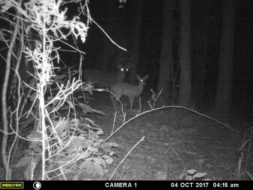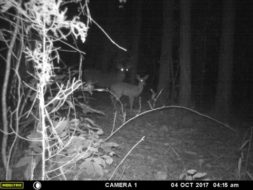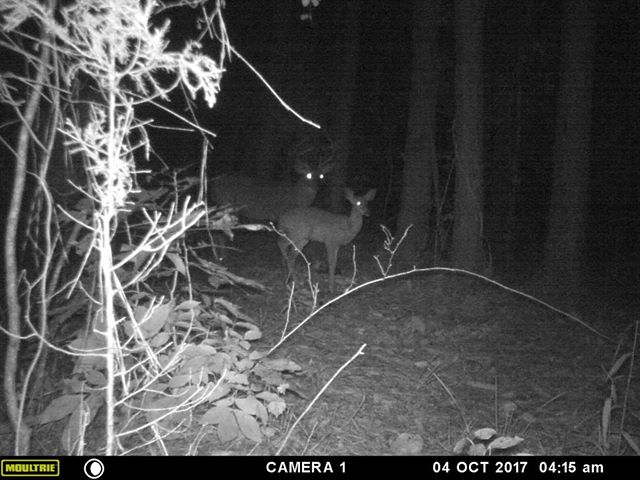 How do you hunt a nocturnal buck? For starters, realize he is probably not as nocturnal as you originally thought. Second, take some extreme measures when heading out to that deer stand or blind.
How do you hunt a nocturnal buck? For starters, realize he is probably not as nocturnal as you originally thought. Second, take some extreme measures when heading out to that deer stand or blind.
Hi Dan,
I’m messaging you because I have always respected you a lot as a hunter, as long as I’ve been following you on social media for years, and I know you know a whole helluva lot more about deer than I do. I’ve also been a fan of Deer Talk Now and Destination Whitetail on Pursuit Channel. I learn more every day.
Anyway, I finally have a consistent TROPHY buck on camera here in South Carolina during the early season. He’s a great deer. He’s been coming out very early in the mornings and the only time I have him on camera during shooting light is this morning, at 7:01 a.m. Temperatures are beginning to drop here, but that’s not saying much because it’s still high 60s, low 70s in the mornings. But we are already seeing signs of pre-rut.
This buck has a scrape about 20 yards from these photos, and there are many huge rubs in the area. Several of the photos actually show him bedded in our bait area! This is on a dirt road that serves as our property line that boarders a cutover that’s not ours. I have a ground-blind stand near this spot, and a bait station about 100 yards from the blind. Anyway, I was just wondering if you could offer me any advice. I would honestly appreciate anything at all. Hunt it? Wait it out? I don’t want to bump him. I am just at a loss and have no clue where to begin. Thank you for whatever advice you can provide! — B.B., South Carolina
Hi B.B.,
Thanks for the note and for the kind words. I appreciate your support over the years!

This is a tough one. These types of bucks are awfully sneaky, and they survive to maturity because they’re smart. It will be hard to kill him, but it can be done. My tactic for hunting these types of bucks is to first get a good read on that travel pattern. Meticulously analyze every photo of every deer on the camera, because the behavior of those other deer will provide clues as to how to hunt this buck as well. Note the exact times each buck shows up and when he leaves, then plan your hunt around that information. Consider this as using “best intel” to predict buck behavior.
Mature bucks are notorious for “staging” in a baited area long before they actually come to the bait. What I mean by that is they hang back in the cover and pretty much just mill around — waiting, watching, observing — until they are fairly certain there’s no danger nearby. They are inherently programmed to be wary of bait stations because they smell the human odor associated with it and through learned behaviors (perhaps as fawns or when they’re yearlings) from being nearby when another deer has been shot. I don’t believe that deer have memories, per se, but I do know that mature bucks show up at night for a reason — they know better!
So, that is my long-winded way of getting to my tactic, and that is simple: Arrive at that stand insanely early — at least 2 hours before daylight is a good rule of thumb — after doing all the rest of your homework on this deer and his behavior near that site. I know that sounds insane, but I learned this trick more than 20 years ago from several of the longtime contributors to Deer & Deer Hunting Magazine. I’ll get to the rationale for the early arrival time in a bit, but first a few more pre-hunt pointers:
- Don’t risk it unless it’s the perfect situation. Do not try to hunt the blind if the wind is not absolutely perfect in your favor. Example: If the blind is to the east of the bait, do not hunt it if the wind is out of the east whatsoever. I would only hunt it if the wind was hitting me in the face or at least a very favorable cross wind.
- Be absolutely meticulous with your scent control. The day before your hunt, “de-scent” all of your clothing and gear. I use Scent Killer Gold on all of my clothing and gear. Spray it down, make sure it dries (outside) and then place all of your stuff in a scent-proof tote or bag. Be especially careful with your boots. Do not wear them while driving to your hunting area. Keep them in a scent-free tote or bag and put them on away from your vehicle. If you have an ozone generator, use that as well.
- Take a shower the morning before the hunt (right before you head out). Again, I use Scent Killer products (body wash and shampoo). Towel off with a scent-free towel. A good tip that I use is that after showering, I get dressed in scent-free sweat pants, socks and t-shirt. I wear rubber clogs when driving and getting my stuff out of the vehicle.

Yes, this all sounds over the top, but it works. Although it has been tweaked some over the years, I adopted a “total scent-free approach” in 1995 after sharing a hunt with the late Gary Clancy of Minnesota. He was one of the best bowhunters I’ve ever had the good fortune of spending time with at a deer camp. He was the first guy I ever met who took scent control to this type of “insane” level. And guess what? He was one helluva successful bowhunter!
Long story short: There is never such thing as too much scent control.
OK, now back to your buck. The rationale for getting to the blind that early in the morning is that through the photos you’ve already captured, you know your only chance is at first light. If you get to the blind well before he might be in the area (which isn’t guaranteed) you at least have a chance of seeing him and not bumping him.
If you bump him (or any other deer, for that matter) on the way to the stand, say a half hour before first light, you will likely not see that buck near the blind again this fall. How long should you hunt the blind? Hunt it for as many hours as you’re seeing deer. If deer are still showing throughout the morning, extend your sit by at least an hour past your last deer sighting. Bumping deer from stand/blind exits is a sure way of making that spot go cold the next time you want to hunt it.
I hope this helps (and makes sense) and I hope the next time I hear from you is with a photo of you with that deer!
Best of luck, Dan






































 How do you hunt a nocturnal buck? For starters, realize he is probably not as nocturnal as you originally thought. Second, take some extreme measures when heading out to that deer stand or blind.
How do you hunt a nocturnal buck? For starters, realize he is probably not as nocturnal as you originally thought. Second, take some extreme measures when heading out to that deer stand or blind.




